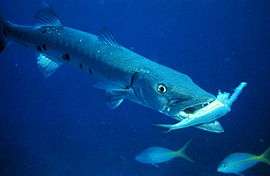Great barracuda
| Great barracuda | |
|---|---|
 | |
| Great barracuda hovering in the current at Paradise Reef, Cozumel, Mexico | |
| Scientific classification | |
| Kingdom: | Animalia |
| Phylum: | Chordata |
| Class: | Actinopterygii |
| Order: | Perciformes |
| Family: | Sphyraenidae |
| Genus: | Sphyraena |
| Species: | S. barracuda |
| Binomial name | |
| Sphyraena barracuda (Edwards in Catesby, 1771) | |
| Synonyms | |
|
List
| |
The great barracuda (Sphyraena barracuda) also known as the giant barracuda, is a common species of barracuda found in subtropical oceans around the world. It is a type of ray-finned fish.
Distribution and habitat
The great barracuda is present in tropical to warm temperate waters, in subtropical parts of the Indian, Pacific and Atlantic oceans, from mangrove areas to deep reef, with a lower depth limit of 110 metres.[1]
Description
Great barracudas are large fish. Mature specimens are usually around 60–100 cm (24–39 in) in length and weigh 2.5–9.0 kg (5.5–19.8 lb). Exceptionally large specimens can exceed 1.5 m (4.9 ft) and weigh over 23 kg (51 lb). The record-sized specimen caught on rod-and-reel weighed 46.72 kg (103.0 lb) and measured 1.7 m (5.6 ft), while an even bigger specimen measured 2 m (6.6 ft) .[2][3][4]
Great barracuda's coloration is blue-gray above, fading to silvery and chalky-white below. Sometimes, a row of darker cross-bars occurs on its upper side, with black blotches on each lower side. The second dorsal fin and the anal and caudal fins range from dark violet to black with white tips.[2][3][4]
In general, barracudas are elongated fish with powerful jaws. The lower jaw of the large mouth juts out beyond the upper. Barracudas possess strong, fang-like teeth that are unequal in size and set in sockets in the jaws and on the roof of the mouth. The head is quite large and is pointed and pike-like in appearance. The gill covers do not have spines and are covered with small scales. The two dorsal fins are widely separated, with the first having five spines and the second having one spine and 9 soft rays. The second dorsal fin equals the anal fin in size and is situated more or less above it. The lateral line is prominent and extends straight from head to tail. The spinous dorsal fin is situated above the pelvis. The hind end of the caudal fin is forked or concave, and it is set at the end of a stout peduncle. The pectoral fins are placed low down on the sides. The barracuda has a large swim bladder.
Behavior and biology

Barracudas appear in open seas. They are voracious predators and hunt using a classic example of lie-in-wait or ambush. They rely on surprise and short bursts of speed (up to 27 mph (43 km/h) to overrun their prey, sacrificing maneuverability. Barracudas are more or less solitary in their habits. Young and half-grown fish frequently congregate in shoals.
They can reach at least 14 years of age.[3] The spawning season lasts from April to October.[1] They can release about 5,000 to 30, 000 eggs.[3] The diets of these top predators of reefs are composed almost totally of fish of all kinds, of cephalopods, and occasionally of shrimps.[1][3] Large barracudas, when gorged, may attempt to herd a school of prey fish in shallow water where they guard over them until they are ready for another hunt.
Barracudas and humans
Like sharks, some species of barracuda are reputed to be dangerous to swimmers. They are scavengers, and may mistake snorkelers for large predators, following them in hopes of eating the remains of their prey. Swimmers have been reported being bitten by barracuda, but such incidents are rare and possibly caused by poor visibility. Barracuda generally avoid muddy shallows, so attacks in surf are more likely to be by small sharks. Barracudas may mistake things that glint and shine for prey.[5] An incident of a barracuda jumping out of water and injuring a kayaker has been reported,[6] but a marine biologist at the University of Florida said the type of wound appeared to have rather been caused by a houndfish.
Handfeeding or touching large barracuda in general is to be avoided. Spearfishing around barracudas can also be dangerous, as they are quite capable of ripping a chunk from a wounded fish thrashing on a spear.
Diamond rings and other shiny objects have been known to catch their attention and resemble prey to them. Caution should be taken when swimming near mangrove coastlines by covering or removing such items.
While barracudas display a disconcerting habit of curiously following divers and swimmers, attacks on humans are rare. Oftentimes, an attack consists of a single strike in which the fish attempts to steal prey from a spear, or else mistakes a shiny object for a fish. While serious, attacks are almost never lethal, bites can result in lacerations and the loss of some tissue.[7]
References
- 1 2 3 4 NatureServe (2015). "Sphyraena barracuda". IUCN Red List of Threatened Species. Version 4.1 (4.1). International Union for Conservation of Nature. Retrieved February 25, 2016.
- 1 2 Florida Museum of Natural History
- 1 2 3 4 5 Marine Bio
- 1 2 Animal Spot
- ↑ Florida Museum of Natural History Ichthyology Department
- ↑ Jumping barracuda injures kayaker off Florida Keys MiamiHerald.com, 6-Oct-2010
- ↑ Great Barracuda nature.org
External links
-
 Data related to Sphyraena barracuda at Wikispecies
Data related to Sphyraena barracuda at Wikispecies -
 Media related to Sphyraena barracuda at Wikimedia Commons
Media related to Sphyraena barracuda at Wikimedia Commons
